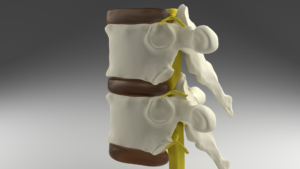When you are affected by pain, daily life, normal activities, and hobbies can become a challenge. Even the amount of sleep you get, the thoughts you have, and basic daily tasks can be negatively affected by pain.
Your quality of life and desire to resume regular activities plays an important role in maintaining your health and managing your pain. There are some positive changes you can make to your lifestyle and simple changes to your daily life that make managing your pain easy.

Tips for Living with Chronic Pain
Lifestyle Changes that Make Living With Chronic Pain Easier
Staying Active
Exercise can help those in pain find the relief they are looking for. Cardio exercise utilizes large groups of muscles and raises your heart rate. This combination releases endorphins. Endorphins are your body’s natural opiate (painkiller). Studies show that exercising for 30-45 minutes of low-intensity aerobic exercise is recommended and can help reduce pain.
Be sure to talk to a doctor before beginning any new exercise program.
A Good Night’s Sleep
Pain interferes with sleep – that’s a no brainer. When you are in pain, you are unable to achieve proper REM cycles and relax enough to get uninterrupted sleep. Pain can cause issues when falling asleep or staying asleep throughout the night.
Certain medications can also cause problems with sleep. If your medication causes drowsiness and fatigue, you may be more inclined to sleep during the day which can mess with your sleep at night. Getting the right amount of sleep at night is crucial to how your body copes with pain and how your body harnesses its energy levels.
Here are some ways to sleep better:
- Stick to a Routine: Creating a sleep routine can help you sleep better. Going to bed at the same time and setting an alarm for the same time every day can help train your body to get more meaningful rest.
- Watch What You Eat and Drink: Certain beverages – such as alcohol or caffeine – can affect your sleep patterns. Heavy meals have the same affect. If you have a snack before bed, eating something healthy like almond butter on toast, crackers and cheese, or nuts and fruit are great alternatives.
- Relaxation: Practicing relaxation techniques before bed can help get your mind and body prepared for a restful sleep. Try things like listening to soothing music, practicing deep breathing, and writing in a journal.
Reduce Stress Factors
Stress and pain go hand-in-hand. Your body may react in different ways when there is stress involved, such as tense muscles or headaches. This can be avoided by reducing stressors and managing stress levels.
Stress can cause negative impacts on your work ethic, eating habits, mood, and relationships. By keeping track of what stresses you out and considering how it affects your life. By eliminating or minimizing the stressors in your life, you may find ways to make your days or weeks go smoother.
Taking your life back from the pain caused by chronic diseases can be solved by adjusting your routine and activities. Contact the team at Progressive Pain Management to learn how to manage your chronic pain. Use the form below to get started.
Facet joints are small, bony joints that sit along the spine. They are paired up from the neck to the lower back area. When the joints get inflamed, they cause pain that can be severe. The pain can be acute or chronic, caused by a variety of conditions.
The pain radiates to other parts of the body and causes indirect pain. For pain that starts in the lower back, it’s common for the pain to move to the thighs and buttocks. If the pain starts in the neck or upper back region, it can transfer to the shoulders, and arms, and even cause headaches.

Facet Joint Injections for Chronic Pain
What is a Facet Joint Injection?
The injection is a strong anti-inflammatory steroid that gets inserted into the facet joint. The medication is a mixture of a local anesthetic and a steroid, similar to a cortisone injection. Before performing the injection, your doctor will explain the procedure, have you sign all the appropriate consent forms, and then have you lie on your stomach.
The procedure is minimally invasive. X-ray guidance is used to locate the facet joints and helps guide the needle to the exact location. The actual injection only takes a few minutes, but you may want to allow for additional recovery time depending on the type of anesthetic you choose. Some doctors will let you choose a local anesthetic or a stronger general anesthetic. The general anesthetic may cause drowsiness and sedation will take longer to wear off.
What to Expect After the Injection?
Right after the injection, you will feel relief from pain. That is due to the anesthetic in the injection, and only lasts for a few hours. The injection site may become sore after a few days, and the pain is not uncommon to resume the day after the injection. About 1-2 days after the injection, the medication will begin to take effect and help reduce your pain on a daily basis.
It is advised to take it easy following the injection and only to resume normal activity when it is comfortable to do so. Your doctor may recommend applying ice to the injection site. This will help reduce any swelling and soreness following the procedure.
How Long Does a Facet Joint Injection Last?
Immediately following the injection, you may feel lessened pain. However, this is temporary relief until the medication kicks in. That can take between 2-7 days after the injection.
If the first injection is successful in managing your pain, your doctor may perform additional injections. The amount of relief depends on your specific pain and because there are a variety of pain receptors in the spine, the long-term effect of these injections cannot be predicted. Everyone’s pain is different, so the treatment effectiveness will vary.
There are very few risks associated with this type of injection. The most common being tenderness and pain at the injection site, although this is temporary. Side effects of steroids may include weight gain, water retention, and temporary increase in blood sugar.
Facet joint injections are an excellent alternative to undergoing serious back surgery. Talk with your doctor today to discuss your options for getting relief from your pain and taking one step closer to bettering your quality of life.
Risks Associated with the Facet Joint Injection Procedure
As with any type of injection or invasive procedure, there are certain risks or complications that could arise:
- Allergies: In most cases, the allergic reaction is caused by the X-ray contrast or steroid, not the local anesthetic. Severe allergies are rare.
- Bleeding: In patients who are taking blood thinners or have a bleeding disorder, it is possible to have some bleeding as a result of the injection.
- Discomfort at the Injection Site: Worsened pain or discomfort at the injection site. Long-term pain is uncommon.
- Infection: Minor infections occur in less than 2% of facet joint injections. More complex infections are rare, only happening in 0.1% of injections.
Fill out the form below to contact the Progressive Pain Management team and learn more about facet joint injections.
Pain does have a purpose, although it can be uncomfortable. When pain overstays its welcome, it can alter your quality of life and prevent you from living your best life.
Chronic pain can be debilitating and for patients who have suffered for years with pain and discomfort, they may not be interested in undergoing perhaps another surgery or trying a new pain medication. Patients who have chronic pain just want relief and to restore a sense of normalcy to their lives.

Learn how to manage your pain on a daily basis
Thanks to extensive research and the evolving field of pain management, there are more options than ever for effectively managing chronic pain on a daily basis, whether at home or on-the-go. Many of these options are natural remedies and can effectively help reduce pain without taking medications.
Ways to Manage Pain on a Daily Basis
- Hot and Cold Compress
Two tried-and-true methods, these are still a great foundation for relieving pain at home. A cold compress can be used to relieve pain, decrease inflammation, and reduce muscle spasms. Heat increases your pain threshold and relaxes muscles. If a homemade ice or heat pack don’t do the trick, as your physician for advice or versions of this treatment method. They may be able to suggest a device or way to apply heat or ice that penetrates deeper into your muscles.
- Therapeutic Massages
While massages can be an indulgence and be very relaxing, they can be very helpful to those in pain. Massages work tension out of muscles and joints and relieve stress and anxieties. Massages often produce a “competing” sensation that is more powerful than pain signals and distracts you from the pain you experience.
- Yoga
Yoga affects all aspects of the body: physical, emotional, spiritual, and vital. The yoga postures (asanas) and breathing aspects (pranayama) affect the psyciological system and trigger a “relaxation response” in the neuroendocrinal system. What this means is that yoga can decrease metabolism, stable blood pressure, reduce muscle tension, and diminish fatigue. Additionally, yoga can help reduce anxiety and stress from coping with chronic pain.
- Biofeedback
Biofeedback combines relaxation techniques with breathing exercises in conjunction with a biofeedback machine. This machine creates data from heart rate and blood pressure into visuals like a graph or animation. Watching that animation gives you a sense of control over your body’s responses to pain.

